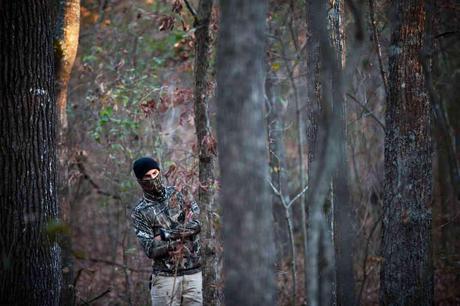
from Earth First! Newswire
In February of this year, radical documentarian Garrett Graham released an excellent hour-long video about the tar sands blockade entitled Blockadia Rising: Voices of the Tar Sands Blockade. The Earth First! Newswire caught up with Garrett to ask him a few questions about his work, the troubled legacy of the blockade, and the difficulty of producing radical documentaries. Enjoy!
1) What was your inspiration for going down to East Texas and filming this incredible stand-off?
The idea to make a documentary film actually came after I was already involved with the blockade. I was one of the original organizers of the Tar Sands Blockade, which began as an idea for one tree-sit but eventually developed into a state-wide movement of its own involving many direct actions, tree-sits and protests. I remember when it was just a few of us meeting land-owners and hearing their stories, wondering what we could do to help. My primary responsibility was creating independent media. These were usually blockader interviews and action videos which we posted on our webpage.
I had just graduated from the University of North Texas that spring where I was studying documentary filmmaking and, I wanted to make sure that these people who were risking everything to stop this pipeline had a chance to tell their story. We knew that the corporate media would either ignore us or vilify us, so we decided that if we wanted to see our story told in our own words we would have to do it ourselves. Producing our own independent, radical media was a part of our plan from the beginning.

In addition to stopping the Keystone XL pipeline, we also wanted to radicalize the climate justice movement by presenting our struggle as an example of an effective direct action campaign. Storytelling was always an integral part of our strategy. We aimed to inspire others. After we had made several action videos for the blockade I realized that we had enough footage to produce a feature-length film. There were many extremely talented people on the media team and we had a lot of cameras on the ground.
I had seen all of the footage and once I realized its potential I knew that I had to edit together this film. It was a matter of solidarity. My friends were risking everything for something they believed in and I had both the privilege and the responsibility of giving their voice a chance to be heard.
2) One thing that comes through in the film is that the activists involved are definitely risking life and limb. Was there any point where you were afraid, yourself, that youd be run over by a tractor, hit by a tree, or whatever?
The five scariest moments of my life all took place during the Tar Sands Blockade. Some of those moments were at the tops of trees and others were on the ground near heavy machinery. During the blockade, the destruction crews working for TransCanada showed complete disregard for the safety of my friends.
As a media person I was very privileged to be able to leave the danger so that I could post videos, but my friends had to remain in harm’s way constantly. I was often worried that some debris might fall on me, but the blockaders were the ones in real danger. To my knowledge, people were tasered, pepper-sprayed, threatened with vehicles and endangered by falling trees. In preparation for the blockade, someone even fell out of a tree and injured their spine. It was a very scary time for us all. I worried constantly for my friends.
3) Filming radicals can be a slippery task. How did you approach people to ensure that you wouldn’t cross anyone’s boundaries?
Maintaining security culture was the biggest challenge on this documentary. Organizing and documenting direct actions is very difficult because you have to balance being a good story teller with being able to keep secrets. Most people in the blockade use aliases for their own protection. This makes it difficult to get someone to sign a release form, so I had to solicit verbal consent from everyone that I interviewed. Nobody ever signed any piece of paper.
Some people chose to be named and others wished to remain anonymous. Having no contracts meant that every time a major change was made I had to re-solicit consent from everyone affected, which was slow and time-consuming. I must confess that although I did my very best to get permission from as many people as I could, I know that I was not able to contact everyone who appears in the film. I haven’t heard any complaints so far. It’s a difficult challenge to keep track of people in a culture of pseudonyms and anonymity.
In addition, I used encrypted hard drives and secure email services for everything and I made that known to the people who trusted me with footage of their activities. Not everyone was convinced though, and at times people were very hostile to the presence of my camera. It was not a friendly environment to film in. However, I allowed the blockaders to see the film first and to raise concerns about incrimination before I released it to the public. I made changes accordingly to protect the identity of the blockaders.
4) Are there any funny stories you’d be able to share about land-owners and radicals interacting in a direct action campaign?
It seems like there would be some hilariously awkward moments, but I could be wrong. It was a very eclectic mix of people inside the Tar Sands Blockade. I have to admit that I found myself surprised by how much I had in common with people I had perceived as being very different from me. I come from the Dallas area and most of my friends are college students. The blockades took place in rural east Texas among ranches and farms.
I had honestly expected more of a culture shock, but everyone that we meet was just happy that we wanted to help them defend their land. They weren’t just self-interested though. I was surprised at how many of them were as concerned about the effects of climate change on others as they were about the effects of this pipeline on their homes. I saw crusty punks and college radicals sharing collective meals with country folk and their families in little tent villages that moved from ranch to ranch. It really changed some of my perceptions.
5) The documentary is very epic in the cinematography. Your filming really captures the beauty of the land in a way I couldn’t have imagined possible (full disclosure, the interviewer was born and raised in Houston). What techniques, cameras, editing equipment did you use to portray and express the beauty of wild nature and the intensity of radical action?
After I graduated from college the first thing I did was buy a camera. It was a Canon Rebel T2i that could shoot high definition video. Most of the other videographers on the media team had their own DSLR cameras too. Occasionally someone had to use a camcorder, but most of the footage came from the DSLR cameras. They are a relatively inexpensive way to shoot high definition digital video.
During my time in the blockade, we were living in outdoor camps beneath the Piney Woods. After spending so much time in those forests we all really came to appreciate their beauty. I never knew that Texas had so much woodland, and I have since learned that this forest used to cover nearly half of Texas. I made time to spend a couple days just hiking the woods and collecting shots of nature.
There is a conflict of imagery in my documentary that I identified as nasty yellow machines versus greenery and trees. I wanted my film to revolve around this repeating visual metaphor. People understand those images. We would often compare ourselves to the Ewoks of Return of the Jedi or the Ents of Lord of the Rings. I wanted to show images that even a child could understand. Luckily, the tar sands already look like Mordor, so all I had to do was make sure that I took the time to record the forest before and after the destruction as well as recording the machinery in action.

6) This film is similar to Pick Axe and some of the other awesome films, but it is in some ways tragic, given the development of the pipeline. How are you, personally, been able to process those feelings, having known and filmed the activists who were tortured by the police and the land-owners who fought against the companies?
Honestly, I have very hard feelings surrounding the Tar Sands Blockade. I helped to get it started, but after a time I had to return to my previous life and put my affairs back in order. I know that many people had to do the same, while others are still just as involved as they’ve always been. I’m inspired that the blockade has taken on a life of its own, but I hate watching the development of the pipeline continue. It sickens me to know that every landowner I befriended eventually had to watch their home be destroyed, and now I am not there to grieve with them. However, we always knew that this struggle was about more than just one pipeline.
We asked ourselves “If this pipeline gets laid in the ground anyway, what will we have accomplished?” and that’s why we prioritized strategic storytelling so that we could inspire others to take action in their own communities. We wanted to radicalize the climate justice movement and I believe that we have done that. The blockade has gotten a lot of attention and I know it has inspired others to take action that might not have otherwise. Even the Sierra Club has chosen to engage in some unprecedented acts of civil disobediences. And of course, the Tar Sands Blockade continues to this day, although my part in it is done for now.
7) Any new projects coming out that you’d like to share with us? What’s next for you?
Right now I am a full-time graduate student at the University of North Texas working towards a Master of Fine Arts Degree in documentary filmmaking. My goal is to continue to tell the stories of resistance that our culture so often ignores or distorts. My friends and I were inspired by the stories told in documentaries like Pick Axe and If a Tree Falls, and seeing people these people take action gave us the courage to do it ourselves. I only hope that my film has played some similar part for others and that I may continue to make films that celebrate and inspire resistance.

